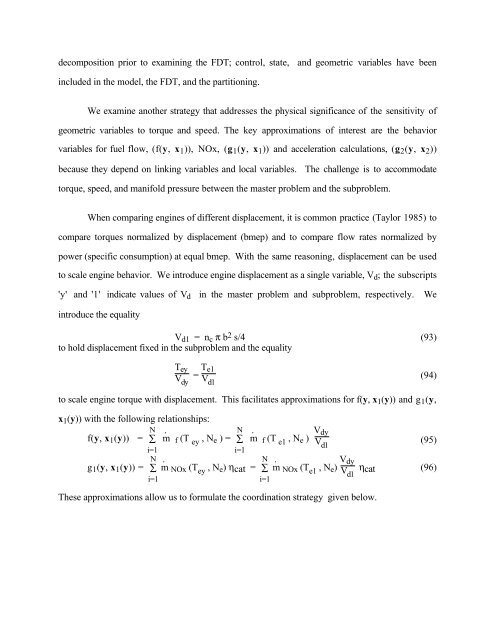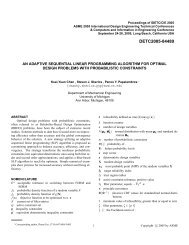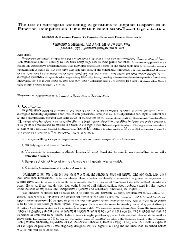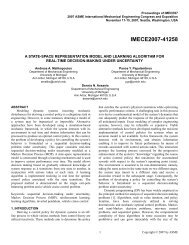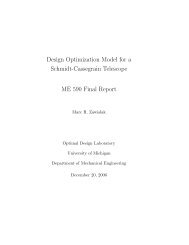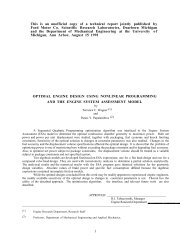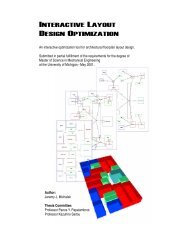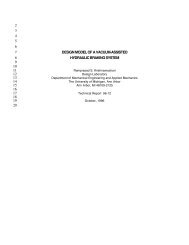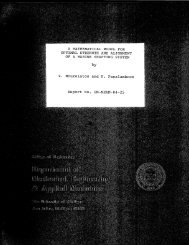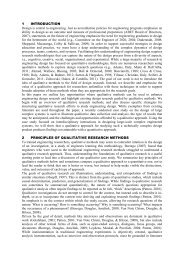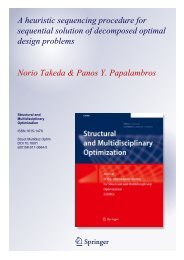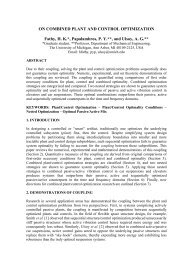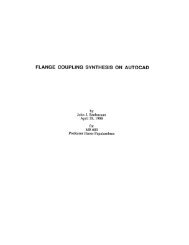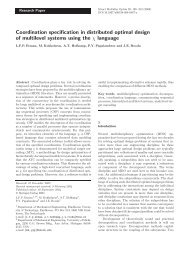Decomposition Analysis of an Automotive Powertrain Design ...
Decomposition Analysis of an Automotive Powertrain Design ...
Decomposition Analysis of an Automotive Powertrain Design ...
Create successful ePaper yourself
Turn your PDF publications into a flip-book with our unique Google optimized e-Paper software.
decomposition prior to examining the FDT; control, state, <strong>an</strong>d geometric variables have been<br />
included in the model, the FDT, <strong>an</strong>d the partitioning.<br />
We examine <strong>an</strong>other strategy that addresses the physical signific<strong>an</strong>ce <strong>of</strong> the sensitivity <strong>of</strong><br />
geometric variables to torque <strong>an</strong>d speed. The key approximations <strong>of</strong> interest are the behavior<br />
variables for fuel flow, (f(y, x 1 )), NOx, (g 1 (y, x 1 )) <strong>an</strong>d acceleration calculations, (g 2 (y, x 2 ))<br />
because they depend on linking variables <strong>an</strong>d local variables. The challenge is to accommodate<br />
torque, speed, <strong>an</strong>d m<strong>an</strong>ifold pressure between the master problem <strong>an</strong>d the subproblem.<br />
When comparing engines <strong>of</strong> different displacement, it is common practice (Taylor 1985) to<br />
compare torques normalized by displacement (bmep) <strong>an</strong>d to compare flow rates normalized by<br />
power (specific consumption) at equal bmep. With the same reasoning, displacement c<strong>an</strong> be used<br />
to scale engine behavior. We introduce engine displacement as a single variable, V d ; the subscripts<br />
'y' <strong>an</strong>d '1' indicate values <strong>of</strong> V d in the master problem <strong>an</strong>d subproblem, respectively. We<br />
introduce the equality<br />
V d1 = n c π b 2 s/4 (93)<br />
to hold displacement fixed in the subproblem <strong>an</strong>d the equality<br />
T ey<br />
V dy<br />
= T e1<br />
V d1<br />
(94)<br />
to scale engine torque with displacement. This facilitates approximations for f(y, x 1 (y)) <strong>an</strong>d g 1 (y,<br />
x 1 (y)) with the following relationships:<br />
N N<br />
f(y, x 1 (y)) = ∑ ṁ f (T ey , N e ) = ∑ ṁ f (T e1 , N e ) V dy<br />
V d1<br />
i=1<br />
i=1<br />
(95)<br />
N N<br />
g 1 (y, x 1 (y)) = ∑ ṁ NOx (T ey , N e ) ηcat = ∑ ṁ NOx (T e1 , N e ) V dy<br />
V d1<br />
ηcat<br />
i=1<br />
i=1<br />
(96)<br />
These approximations allow us to formulate the coordination strategy given below.


